Intern Weekly Response: Social Media

Every week we’re asking our summer interns to share some thoughts and responses to various experiences and readings. This week we asked them explore the world of social media. To read more posts from JMM interns, past and present, click here.
~Intern Cara
While I was a little late to the Instagram game (I joined in 2014) it has quickly become my favorite social media platform. I’m a very visual person and I love scrolling through my newsfeed (which to be honest mostly consists of food blogs) of carefully staged, edited, and filtered photos. My favorite posts are a combo of artistic photos, clever captions, and the perfect selection of emojis and hashtags. I think JMM’s social media manager, Rachel Kassman has done an awesome job with our Instagram account. Her voice and sense of humor shines through without overpowering the voice of the museum. My favorite series of posts are #MugShotMonday. I love the hashtag and think it’s a really clever way to show off the many coffee mugs JMM has for sale in its gift shop. I also love the variety of posts. The account features everything from objects and documents in our collections to the various projects staff and interns are working on.
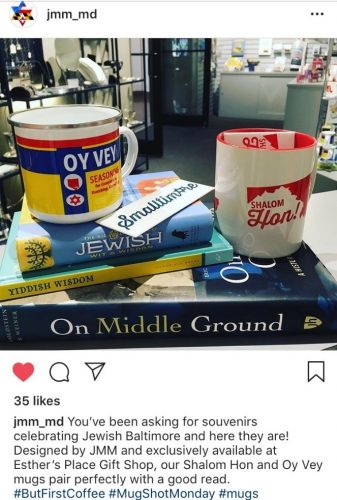
Currently the JMM’s Instagram account has a relatively small following (last I checked we were at 564 followers). I think a great way for the JMM to increase in engagement and its fanbase would be to follow other like-minded institutions on Instagram and its other social media platforms. The National Museum of Jewish American History in Philadelphia (@americanjewishmuseum) and The Contemporary Jewish Museum in San Francisco (@jewseum) are both great accounts for the JMM to follow.
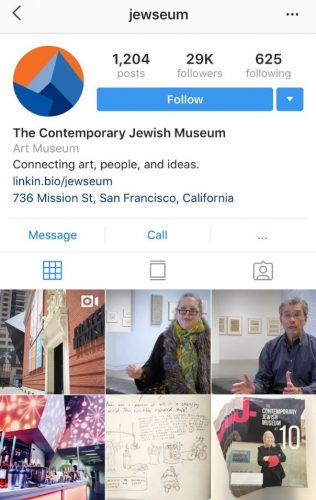
#TweetMe @jewishmuseummd
~Intern Alexia
Interaction with the public is extremely important for museums. Now days museums can engage with their visitors through social media. Social media allows museums to have a personality and intermingle with its audience in a more relaxed way. This also allows museums to know its main audience and expand it. But social media accounts do not only help museums make connections with their visitors, it also allows museums to form relationships with other institutions. Through social media museums can also participate in conversations of current events. One of the ways the Jewish Museum of Maryland interacts with their audience is through their twitter account (@jewishmuseummd).
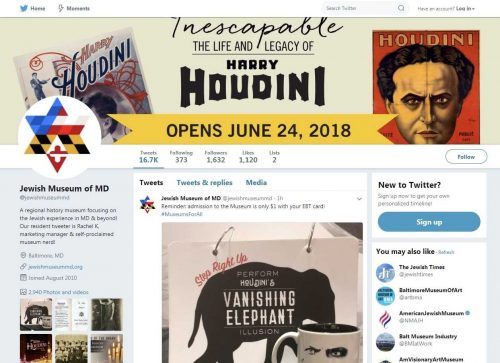
One the things I like the most of the JMM’s twitter account is how it keeps the audience updated on the exhibits and current events. The museum does this by keeping it’s posts short and adding a picture that catches the viewers’ eye. An example of this would be the museum’s promotion of Inescapable: The Life and Legacy of Harry Houdini. To promote the exhibit the museum interacted with its audience by asking questions and showing snippets of the exhibit.
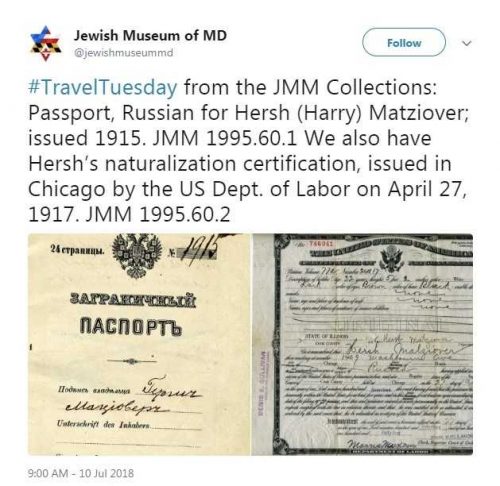
My favorite way in which the JMM’s twitter account interacts with its audience is when it shares parts of the Museum’s collection. One of the way the JMM shares its collection is with #TravelTuesday. Every Tuesday the JMM shares an artifact of their connection that is related to traveling. The tweets often have a small background of the artifact and a picture, which allows the viewer to learn a new fun fact or interesting topic. #TravelTuesday also allows the Museum to make connections with their current exhibitions: Inescapable and Voices of Lombard Street: A Century of Change in East Baltimore.

Don’t forget to follow the JMM’s twitter account (@jewishmuseummd) and let us know what your favorite part of our exhibits is!
If you enjoy the JMM’s twitter account be sure to check out the Wellcome Collection’s twitter account @ExploreWellcome and the Victoria & Albert’s twitter account @V_and_A. Both accounts constantly interact with their audiences through their collections on twitter by making them relatable to them. The accounts also engage with their audience and other museums in a relaxed way.
The Jewish Museum of Maryland’s Use of Tumblr
~Intern Marisa
After spending some time investigating our beautifully laid out and designed Tumblr account, I came to the realization that a large amount of our posts on Tumblr are links to our blog, or the same posts on our Facebook page. I think some would say that this reuse of content is a bad thing, but I based upon my knowledge of Tumblr, I believe that it taps into a completely different audience than our Facebook. While our Facebook connects with anyone who has liked our page (or in some cases a similar page), on Tumblr the tagging system makes it so anyone searching a shared tag may stumble accidentally upon our posts. Additionally, Facebook and Tumblr attract different audiences, and thus, the duplicate posts do serve the museum well.

My favorite post on our Tumblr, currently, is actually something that doesn’t fall into those two categories. Namely, this was a link to a reading list of books about Jewish women in the LGBTQIA+ community. One of my biggest passions is reading, recommending, and championing diverse literature: the books that are forgotten, ignored, and not often taught in academic institutions. I was thrilled to see the museum taking similar steps on our Tumblr and raising awareness of these books.
Overall, I would say that our Tumblr, right now, is a second platform for the posts we write for Facebook, and since Tumblr often attracts a different audience, I think this is a good use of our account. However, Tumblr is also an exciting space in which we can recommend reading, whether books or articles, share different items from our collection, and make connections/collaborations with other local (or even distant) museums.
Marisa’s recommended Museum Tumblrs:

Libraries are just museums that are filled with books, right? I’m just kidding, but seriously, in addition to being a filming location of the original Ghostbusters and a hub for intellectual curiosity, the NYPL does have rotating exhibitions (most notably right now an exhibit on Shared Sacred Sites). The NYPL Tumblr does a great job of balancing reading lists, library events, and items from their collection.
The Philadelphia Museum of Art:

The Philadelphia Museum of Art is sharing their exquisite, extensive, and myriad collection on their Tumblr. What I particularly like about their Tumblr are their posts that collect several works of art that are connected by a particular theme. Like this post about waterfalls for instance. Where they can, they also offer multiple, detailed photos that draw the reader’s attention, like this post about a shield painted in 1535. Their Tumblr also provides reminders about upcoming events and serves as an additional outlet to reach new and continuing visitors.
Instagram and Nuggets of History
~Intern Ash
The Jewish Museum of Maryland’s Instagram page is filled with little nuggets of Baltimore and Maryland history. From old black and white photographs to pictures of us current interns, the JMM focuses its Instagram page mostly on happenings around the museum and historic photographs from its collections.
Out of the more recent posts on the JMM’s Instagram page, the ones that I feel are doing the best put a spotlight on some part of Maryland or Baltimore history, and teach me something I didn’t know before. The Hendlers Ice Cream posts, especially this one, taught me a bit about the history and advertising of ice cream in the early to mid-1900s in Baltimore. I didn’t think I would find a description of a “Kewpie,” a cherubic illustrated character, on the JMM’s page, and so this nugget of information surprised me. The small Kewpie illustrations that dot the Hendlers Ice Cream posts are fun and give a joyful energy to the JMM Instagram page.
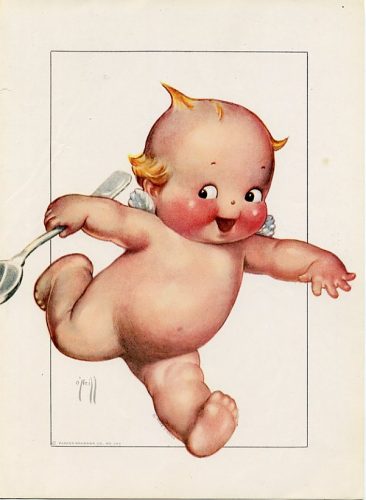
Seeing how much I like the Kewpies, I would like to see more little tidbits of Maryland and Jewish history in the JMM’s Instagram captions. Because the JMM’s Instagram page has a focus on historic photographs and documents (as opposed to other museums that may be illustration or art-heavy), I feel like the descriptions become very important to the viewer’s connection and accessibility to the artifact and its history.
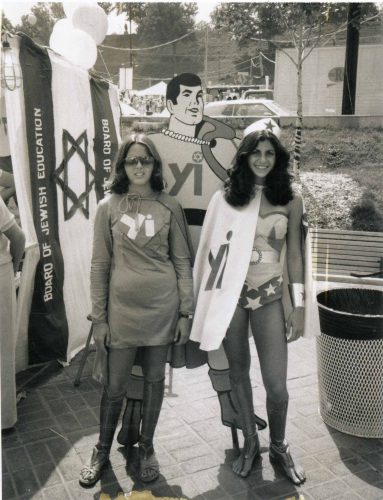
Museums can also take distinct approaches on how to use Instagram as a platform. Two museums that I feel are worth looking at for their Instagram, and take different but fun approaches, are The Contemporary Jewish Museum (@jewseum) and The Wellcome Collection (@wellcomecollection). The Contemporary Jewish Museum posts only once every few days, and makes the most of it, using Instagram mainly as a platform for advertising their events and exhibits through high-quality photos. The Wellcome Collection, on the other hand, uses its page as almost a digital look through their collection, while creating a whacky sort of personality through their descriptions and content. They also do a good job of providing ample information (or just enough, depending on the post) while still dividing it up in a digestible way for viewers. As shown with these different accounts, Instagram can become an additional medium to connect with an audience, whether it’s used to advertise, educate, or start a conversation within a museum community.
